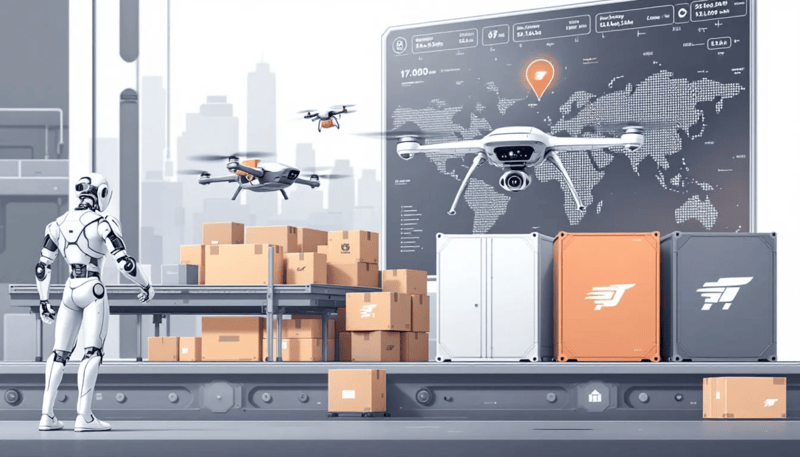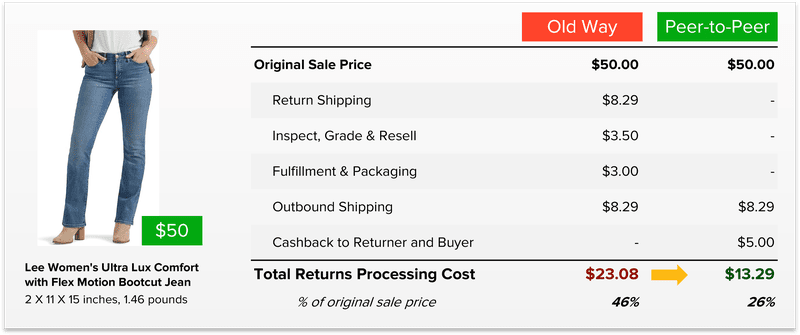Best Ecommerce Shipping Solutions for 2025: Streamline Your Delivery Process

Last updated on March 20, 2025

In this article
 18 minutes
18 minutes
- Key Takeaways
- Understanding Ecommerce Shipping Solutions
- Key Features to Look for in Ecommerce Shipping Solutions
- Choosing the Right Shipping Solution for Your Business
- Top Ecommerce Shipping Solutions in 2025
- Enhancing Customer Experience with Shipping Solutions
- Reducing Shipping Costs with Advanced Solutions
- Streamlining Your Order Fulfillment Process
- Ensuring Security and Compliance
- Using Analytics to Optimize Shipping Operations
- Summary
- Frequently Asked Questions
Looking for the top ecommerce shipping solutions to improve your business? This guide highlights the best options for 2025 to streamline delivery, cut costs, and boost customer satisfaction. Pay special attention to those that are future proof.
Key Takeaways
- Ecommerce shipping solutions are critical for optimizing delivery processes and enhancing customer satisfaction, emphasizing the need for efficient strategies amidst industry competition.
- Key features for effective shipping solutions include integration capabilities, multi-carrier support, automation, and cost optimization, which are essential for improving operational efficiency.
- Future trends in ecommerce shipping focus on sustainability and technology, with advancements such as AI and machine learning optimizing logistics and enhancing eco-friendly practices.
Understanding Ecommerce Shipping Solutions
Ecommerce shipping solutions manage the entire fulfillment workflow: delivering products from the point of order completion to the customer’s doorstep, making them essential for business success. These solutions are not just about moving packages from point A to point B; they are about optimizing every step of the shipping process to ensure efficiency and customer satisfaction. Therefore, shipping solutions play a critical role in differentiating your business and keeping customers happy.
Online businesses face unique challenges in shipping, such as managing costs while meeting customer expectations for timely delivery. An effective shipping strategy must include key components like carrier selection, tracking methods, and cost management to navigate these challenges successfully. The shipping process directly impacts customer experience, with efficient packaging and timely delivery being crucial for customer satisfaction and retention.
Looking ahead, future trends in ecommerce shipping are focused on technological advancements and sustainable practices. These aim to improve efficiency and meet the evolving demands of customers, making it more important than ever to stay ahead of the curve.
Key Features to Look for in Ecommerce Shipping Solutions
Identifying the right ecommerce shipping solution begins with understanding its integration capabilities with existing sales channels and business software.
Factors to consider when selecting shipping solutions include:
- Integration capabilities
- Scalability
- Automation
- Flexibility
- Cost optimization
These features are crucial for ensuring efficient operations and meeting customer expectations. Prioritizing these features helps businesses optimize shipping processes and enhance overall performance. Key features to consider in ecommerce shipping solutions include integration capabilities, multi-carrier support, and automated label creation and printing.
Integration Capabilities
Seamless integration with your existing tech stack is a game-changer. It’s almost table stakes today, but suffice to say that robust shipping software allows for seamless integration with your channels as well as all of the different order management and fulfillment processes, improving overall efficiency. Integrating shipping software with ecommerce platforms automates tasks like order import, updating stock levels, and reducing manual data entry and errors. This creates a workflow where orders from your ecommerce platform automatically sync with your shipping software, but without overselling, ensuring a seamless customer experience.
Cahoot, for instance, integrates with all popular marketplaces and ecommerce platforms and can connect with custom-built software via an API. This level of integration not only streamlines shipping workflows but also enhances inventory management, ensuring that your stock levels are always accurate across all sales channels.
Multi-Carrier Support
Having access to multiple shipping carriers is a significant advantage. It enables businesses to offer competitive rates and diverse delivery options to customers of all demographics. Shoppers today expect a variety of shipping options, including next-day delivery, flat-rate shipping, and international shipping.
Shipping software with multi-carrier support facilitates rate comparisons, optimizing delivery times and costs. UPS, USPS, DHL Express, and Canada Post, for example, offer pre-negotiated rates that can provide cost savings to customers during checkout. This flexibility ensures that you can meet customer expectations without breaking the bank, especially when using the best shipping software, and efficient and reliable shipping services that deliver on time.
Automated Label Creation and Printing
Automated label creation and printing solutions significantly expedite the preparation of packages, enhancing operational efficiency while ensuring the optimal label is used for the specific shipping circumstance. Autonomous label creation reduces manual work, minimizes errors, accelerates fulfillment, and creates the cheapest shipping label using real-time carrier rate shopping, which is particularly beneficial as shipping volume increases.
Shipping platforms should feature batch shipping label creation and printing capabilities to prepare all necessary labels for the day’s shipments autonomously with just a few clicks to dramatically speed up order fulfillment and reduce the risk of errors.
Choosing the Right Shipping Solution for Your Business
Selecting the right shipping solution is crucial for ecommerce businesses to improve efficiency and meet their specific logistics needs. An ecommerce fulfillment warehouse plays a key role in managing order processing and shipping, making it essential to choose a solution that complements your fulfillment strategy.
Deciding on shipping rates and methods is a critical first step before shipping ecommerce orders. Next-generation shipping software must simplify operational complexities, drive efficiencies, and generate meaningful cost savings. Legacy shipping software can create more problems for Sellers as it is not equipped to handle the complexities of distributed fulfillment.
Understanding your shipping volume, managing costs, and ensuring international compliance are key factors in this decision-making process. Let’s explore these in more detail.
Assessing Your Shipping Volume
Understanding your shipping volume is essential for choosing a solution that can grow with your operational needs. It needs to accommodate seasonal spikes and consistent growth.
Recognizing and preparing for shipping volume fluctuations can help ensure that the selected solution meets both current and future business demands. This preparation is vital for maintaining efficiency and customer satisfaction during peak times.
Cost Management and Discounted Rates
Cost management is a cornerstone of any effective shipping strategy. Negotiating shipping contracts for bulk shipments often leads to favorable rates and significant savings. Analyzing shipping costs as a percentage of sales can highlight the impact of shipping on overall profitability.
Data analysis can uncover specific shipping routes and methods that lead to higher costs, allowing businesses to adjust their strategies for savings. Using shipping software can enhance carrier rate negotiations and streamline shipping processes, making cost management more efficient.
International Shipping Compliance
Compliance with international regulations is crucial to avoid delays in package delivery. Customers are responsible for additional customs fees at delivery, which can cause friction if not handled properly.
Accurate completion of customs forms is necessary to prevent packages from being held up. These forms can be obtained online or at local post office/shipping retail locations. Ensuring compliance can help businesses avoid potential fines and restrictions on future shipments.
Top Ecommerce Shipping Solutions in 2025

Several top-tier ecommerce shipping solutions have emerged as leaders in 2025, each offering unique features and benefits. These include Cahoot, ShipStation, and Easyship. Each of these solutions provides distinct advantages that can help streamline your shipping workflow and wow your customers.
Exploring these options helps you find the best fit for your business needs and budget:
Cahoot
Cahoot is a next-generation, humanless ecommerce shipping software designed for high-volume merchants, but is so easy to use that businesses of any size can take advantage of the future proof technology. Because 97%+ of shipping labels are rate shopped and pre-created before you show up to the warehouse with coffee in-hand, it allows users to bulk-print labels with just one click, enabling immediate shipping. This feature streamlines order fulfillment by eliminating the need for manual rate comparisons and speeding up the shipping process by as much as 21X or more.
Cahoot integrates with all popular marketplaces, ecommerce platforms, and carriers, and can connect with custom-built software via an API. It notifies Sellers whenever a problem occurs with carriers delivering packages, allowing for proactive resolution and a better customer experience than competitive solutions.
ShipStation
ShipStation supports multi-carrier shipping, allowing businesses to compare rates and choose the best option for each shipment. It incorporates automation rules to efficiently manage shipping tasks, significantly reducing manual intervention and errors. And it has more integrations available than just about any other solution, including very niche and long-tail platforms.
Through branded tracking pages, ShipStation enhances the customer experience by allowing businesses to maintain their branding throughout the delivery process. This feature ensures that customers have a consistent brand experience from purchase to delivery.
Easyship
Easyship is a cloud-based shipping solution that offers discounted shipping rates, customer tracking, seamless integration, and dynamic rates at checkout. These discounted shipping rates can significantly reduce costs for businesses.
The dynamic rates at checkout improve conversion rates by providing customers with real-time shipping costs. Additionally, Easyship’s comprehensive tracking features allow customers to monitor their shipments effectively, enhancing the overall customer experience.
Enhancing Customer Experience with Shipping Solutions
Delivering an exceptional customer experience is of utmost importance (no pun intended). Efficient shipping not only improves the bottom line, but it supports ongoing customer relationships, potentially increasing sales and loyalty. Shipping costs play a crucial role in ecommerce profitability, making cost reduction vital for retaining customers. An effective shipping strategy can reduce customer inquiries about order statuses, allowing support teams to focus on other issues.
Incorporating features like real-time tracking and notifications, flexible delivery options, and branded packaging and tracking pages can elevate your shipping strategy to new heights.
Real-Time Tracking and Notifications
Real-time tracking is essential for keeping customers informed about their orders. Shipping solutions should provide visibility into shipment tracking, consolidating all orders in one interface for wider visibility and easier management. Automated notifications throughout the fulfillment and shipping timeline can reduce customer anxiety, improve satisfaction, and limit the customer service burden.
Shipment notifications can be delivered via various channels, including email, SMS, and mobile app alerts, keeping customers engaged and informed. This level of transparency and meeting the customer where they are can significantly boost their confidence in your business.
Flexible Delivery Options
Offering flexible delivery options is crucial for today’s online shopper. According to many studies, customers prefer flexible delivery options. Providing diverse shipping methods allows customers to select options that best meet their needs, budgets, and availability.
Having multiple delivery options can enhance customer satisfaction and minimize the likelihood of cart abandonment. This flexibility ensures that your customers can choose the delivery method that works best for them, making their shopping experience more convenient and enjoyable.
Branded Packaging and Tracking Pages
Branded packaging and custom tracking pages play a crucial role in shaping customer perceptions and experiences during the shipping process. Customized tracking pages can enhance the customer experience by providing a branded touchpoint during the shipping process.
Integrating branded packaging and custom tracking pages not only elevates the customer experience but also fosters brand loyalty and reduces the likelihood of cart abandonment. This cohesive branding can make a lasting impression on your customers, encouraging repeat business and positive reviews.
Reducing Shipping Costs with Advanced Solutions
Shipping costs are a significant expense for ecommerce businesses, and reducing these costs can improve profitability. Key metrics to monitor include on-time delivery rates, shipping costs per shipment, and carrier performance on speed and reliability. Tracking shipping expenses over time allows businesses to identify cost trends and potential financial issues.
Advanced solutions like rate comparison tools, volume discounts, and efficient packaging strategies can help reduce shipping costs and streamline operations.
Rate Comparison Tools
Shipping rates are influenced by various factors, including courier options and unique business variables. Using rate comparison tools in ecommerce shipping allows businesses to identify the best shipping rate deals available in the market.
Cahoot, for example, automatically finds and assigns the lowest cost labels for each order, ensuring users save money on every package shipped without compromising delivery speed. Utilizing lightweight packaging like poly mailers can further reduce shipping costs as they adjust to different volumes and weights.
Volume Discounts
Consolidating shipping volumes helps businesses negotiate better rates with carriers. Volume discounts can significantly lower shipping expenses for ecommerce businesses. Securing volume discounts allows businesses to optimize their shipping costs and improve profit margins.
Overall, leveraging volume discounts through an effective ecommerce shipping strategy can enhance the efficiency and cost-effectiveness of ecommerce operations.
Efficient Packaging Strategies
Optimizing packaging can lead to lower shipping rates and reduced operational costs. Understanding the average package weight can help in optimizing packaging to minimize shipping costs.
Businesses should consider carrying a variety of package sizes and materials to meet diverse shipping needs efficiently. This approach not only reduces packaging costs but also ensures that products are protected during transit, reducing the risk of damage and returns.
Streamlining Your Order Fulfillment Process
Streamlining your order fulfillment process is necessary for improving efficiency and customer satisfaction. Fulfillment services can enhance the efficiency of order processing by managing logistics and inventory storage. Using platforms like ShipStation simplifies the management of orders and fulfillment workflow by automating order imports and logistics.
Partnering with third-party logistics providers can significantly improve customer experience by streamlining logistics operations. Regularly monitoring shipping metrics such as delivery times and order accuracy will help you stay on top of your shipping performance and bring clarity when deciding if outsourcing fulfillment should be considered.
Leveraging route optimization tools can significantly reduce delivery times by identifying the fastest paths for shipment.
Batch Processing and Automation
Implementing batch processing can significantly enhance the speed of order packing and shipping. Automated systems can cut down the time required for packing and shipping orders. Data analytics can pinpoint inefficiencies in shipping routes and processes, enabling targeted cost-reduction strategies.
This level of automation and data-driven decision-making can make a substantial difference in your order fulfillment efficiency.
Inventory Management Integration
Integrating shipping solutions with inventory management software ensures that stock levels remain accurate across all sales platforms, and minimizes double data entry (or triple, or more!). Or better yet, select a solution that has inventory management capabilities built-in.
Effective integration with ecommerce platforms can streamline the order fulfillment process, ensuring that your inventory is always up to date and that orders are processed efficiently.
Scheduling Carrier Pickups
Scheduling carrier pickups helps businesses manage their shipping tasks more effectively. Scheduling pickups helps businesses streamline the shipping workflow, provide predictability, and reduce time spent dropping off packages at carrier hubs. Arranging carrier pickups can eliminate the need to stand in lines, saving time and resulting in smoother operations. Some ecommerce shipping solutions such as ShipStation will allow you to schedule pickups from within their software.
Ensuring Security and Compliance
Ensuring security and compliance is essential for maintaining customer trust and avoiding legal issues. Ecommerce businesses must implement robust security measures to protect customer data. Ecommerce brands face increased risks just having access to this sensitive information due to multiple parties needing access to order data, making shipping insurance essential.
International regulations, paperwork, customs forms, and duties calculations are required for shipping to ensure compliance. Regulations are increasingly mandating reduced packaging waste, pushing ecommerce brands to adopt sustainable packaging solutions.
Shipping Insurance
Shipping insurance is vital for protecting shipments, helping ecommerce businesses manage risks associated with theft, loss, and damage during transit. For imported inventory, marine cargo insurance provides comprehensive coverage for the full value of goods throughout their shipping journey from overseas. Consumer delivery insurance allows customers to insure their shipments during checkout, addressing concerns about theft or damage. Limited liability insurance relies on carriers’ own policies, which typically cover only minimal amounts, resulting in a riskier option for ecommerce companies. While this latter option is free up to $50 or $100 declared value, depending on the carrier used, getting claims approved is often impossible, so it’s best to protect the goods when it makes sense to do so. Using inexpensive third-party cargo insurance is recommended.
Data Security Measures
Shipping solutions must implement robust data security measures to protect sensitive customer information from unauthorized access. Encryption protocols are essential for protecting customer data during transactions and communications. Encrypting sensitive information, using firewalls, and maintaining antivirus protection are essential for data security in ecommerce.
Authentication methods such as two-factor verification and IP monitoring help ensure secure online transactions. And sensitive data should be redacted from ecommerce shipping solutions after transactions are settled and no longer needed.
Using Analytics to Optimize Shipping Operations
Using analytics in shipping operations can significantly enhance overall efficiency by identifying areas for improvement. Regular updates and audits of ecommerce software are critical in preventing vulnerabilities from being exploited. Emerging technology in shipping includes AI and predictive analytics, which enhance demand forecasting and operational efficiency.
AI applications in shipping help companies predict demand by analyzing historical data and live market trends. Agentic AI solutions can act on their findings independently and create Purchase Orders with vendors within established budget guidelines. By leveraging advanced analytics, businesses can make data-driven decisions that improve their shipping and procurement operations.
Tracking Performance Metrics
Tracking key performance metrics is essential for evaluating shipping efficiency and delighting customers. Use tools to monitor on-time delivery rates as higher percentages correlate with customer happiness.
Average delivery time is also an important metric, helping businesses gauge their shipping efficiency against industry standards and delivery promises. Shipping software analyzes shipping data to provide insights into business performance and optimize logistical efficiency.
Identifying Cost-Saving Opportunities
Analytics can reveal cost drivers linked to various carriers and services, shipping supplies, and waste from inefficient shipping such as using boxes that are too large and push the shipment into more expensive dimensional weight rates. Reviewing the data enables businesses to negotiate better rates on the shipping weights, sizes, and zones they are actually using while minimizing unnecessary expenses.
Improving Delivery Times
Utilizing data insights can significantly enhance the optimization of delivery routes for ecommerce businesses. Advanced analytics enable companies to analyze traffic patterns, weather conditions, and delivery performance to select the most efficient routes and shipping locations to reduce transit times, fuel consumption, and operational costs. The effective application of data insights in delivery planning leads to faster delivery times, higher customer satisfaction, and improved overall efficiency.
Summary
Choosing the right ecommerce shipping solution involves understanding your business needs and the key features that can optimize your workflows and deliver meaningful business impact. From integration capabilities and multi-carrier support to automated label creation and printing, these features play a crucial role in enhancing operational efficiency and customer satisfaction. As ecommerce continues to evolve, adopting advanced shipping strategies and the solutions that support them will be key to maintaining a competitive edge and ensuring long-term success.
Frequently Asked Questions
What are the key features to look for in ecommerce shipping solutions?
When selecting ecommerce shipping solutions, prioritize integration capabilities, multi-carrier support, automated label creation and printing, cost management, and compliance with domestic and international regulations.
How can I reduce shipping costs for my ecommerce business?
To effectively reduce shipping costs for your ecommerce business, optimize packaging for weight and size, utilize flat-rate shipping options for heavy items, explore discounted shipping rates, and offer local delivery or pickup. Many platforms like Cahoot, ShipStation, and Easyship offer discounted shipping rates through their carrier relationships that can save many thousands of dollars. Also, utilize rate comparison tools, secure volume discounts, and optimize your packaging strategies (shipping supplies and cartonization technology). These approaches will help you streamline expenses and enhance profitability.
Why is real-time tracking important for ecommerce shipping?
Real-time tracking is crucial for ecommerce shipping as it enhances customer satisfaction by keeping them informed about their order status, thereby reducing anxiety associated with uncertainty. This transparency fosters trust and loyalty towards the brand.
What is the best online shipping service?
The Top 3 Online Shipping Services are:
- Cahoot
- ShipStation
- EasyShip
What’s the difference between Cahoot’s network and Cahoot’s shipping software?
Cahoot’s platform is a peer-to-peer order fulfillment services network where top-rated merchants share warehouse space and fulfillment services with one another. Cahoot’s shipping software is next-generation ecommerce shipping software that can support any size merchant, including high-volume merchants shipping millions of parcels per year. Merchants can use either or both. Our fastest-growing clients use both.
What are the carriers for ecommerce shipping?
The most common national carriers are UPS, USPS, and FedEx, while popular regional carriers include OnTrac, Courier Express, and PITT OHIO, among others. Amazon Shipping will soon be matching the last-mile delivery reach of the national carriers. For international shipments, DHL Express and GlobalPost are most common, however, UPS, USPS, FedEx, and many other carriers also support international deliveries.
How to ship items you sell online?
To ship products from your house, you can use a shipping carrier like USPS, FedEx, or UPS. First, package your product securely and weigh it to determine the shipping cost. Then, create a shipping label online and either schedule a carrier pickup or drop them off at a carrier location. You can also purchase postage and drop your packages off at the same time at any post office, The UPS Store, and/or FedEx Office location.

Up to 64% Lower Returns Processing Cost


